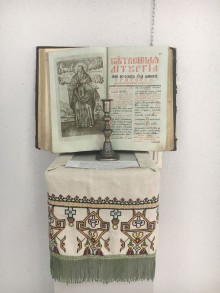The picture gallery of the Ancient Halych National Sanctuary is hosting an exhibition “Galician Old Printed Church Books of the 17th-20th Centuries,” which will last until July 7. The exposition reflects the work done by the religion studies expeditionary search party comprising employees of the Ancient Halych National Sanctuary’s research and education department and holdings department. The organizers of this event intended it to mark two anniversaries at once: 1,120 years since the first written mention of Halych and 715 years since the establishment of the Galician Metropolitanate.
The core exhibits include church liturgical books illustrated with Renaissance and Baroque engravings created by famous masters of the engraving art: Brother Ilia, Brother Dorofei, Vasyl Ushakevych, Yefstafii Zavadovsky, Yosyf and Adam Gochemskys. To highlight the most important ones, I would like to mention the Apostle of 1639, the Gospel of 1644 (published by Mykhailo Sliozka), and the Gospels published by the Lviv Brotherhood in 1670 and 1690 and the Pochaiv Monastery in 1780. Among other holdings, there are valuable publications of the Kyivan Cave Monastery, the Univ Monastery, and the Przemysl Cathedral on display.
“The idea to create such an exhibition occurred to us two years ago during an expedition to churches of the Halych raion. Then one of the priests, Father Vasyl Zaverach, handed over to the sanctuary two old printed books, copies of the Gospel of 1670 and the Gospel of 1780. After a detailed study of the sacred objects, we discovered donor inscriptions of the early 18th and the first third of the 19th century, respectively, on the pages of these books. At the same time, the first inscription, as well as the book itself, was linked to a church that does not exist anymore (St. Epiphany in Zalukva neighborhood of Halych),” Candidate of Historical Sciences, head of the Ancient Halych National Sanctuary’s research and education department Andrii Stasiuk told me.
The organizers say that the exhibition has a dual purpose. Firstly, it is intended to demonstrate the cultural wealth hidden from the eyes of the laity, which sometimes just gathers dust in churches. Secondly, the old printed books also have an important historical value, because their margins frequently bear donor inscriptions as well as records of historical events or even harvests and natural disasters. Apart from it, researchers take interest in the engravings on these texts’ pages: at times, an image may be older than the book by several decades, and even a whole century on some occasions.








